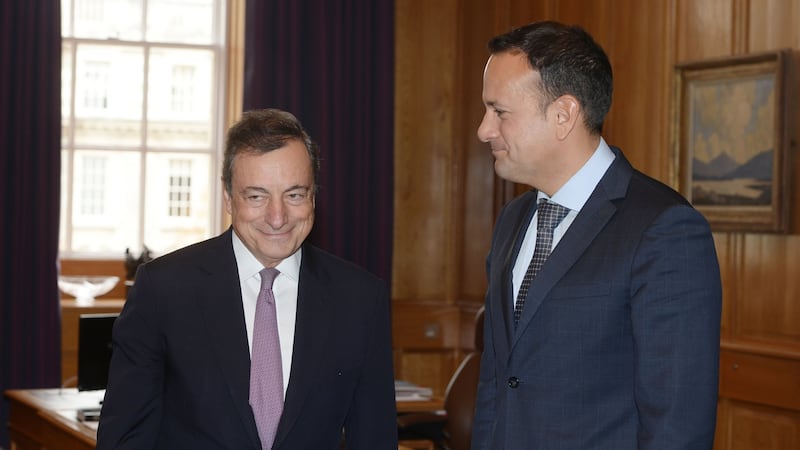A decade after Irish banks threatened the solvency of the State, Minister for Finance Paschal Donohoe could be forgiven for still not wanting to listen to bankers.
But he's surely rueing not heeding a call from AIB's chief executive Bernard Byrne weeks before Christmas last year to press ahead with the sale of further shares in the bank, months after the Government raised €3.4 billion by flogging a 28.8 per cent stake to stock market investors.
Shares in AIB have subsequently slumped by a third in value and are wallowing about 16 per cent below their initial public offering (IPO) price, hit by the general malaise that set in across global markets in 2018, concern over Brexit, and weaker-than-expected mortgage growth.
Byrne's decision in October to hand in his notice, only weeks after his chief financial officer Mark Bourke signalled he was leaving, have all but killed off any prospects of Donohoe approaching the market with more AIB shares any time soon.
Tracker-mortgage scandal tops €1bn
This year also saw the cost of the tracker-mortgage scandal top the €1 billion mark as lenders continued to set aside more money to deal with refunds, compensation, expenses and likely regulatory fines. As of the end of August, banks had acknowledged 38,400 cases where borrowers were wrongfully denied their right to a cheap mortgage tracking the European Central Bank’s (ECB) main rate, or put on the wrong rate entirely.
More than three years after regulators ordered lenders to review their home loan books, the next Central Bank update in January is set to show yet another increase in the number of impacted customers. Still, Central Bank governor Philip Lane told The Irish Times in late November that he expected a final report on the saga to be published early in 2019.
Ulster Bank upheaval
Ulster Bank, the laggard among banks in making redress and compensation payments to tracker customers because of issues with its IT systems, also announced in January that its chief executive of 18 months, Gerry Mallon, had handed in his notice as he lined up a job as CEO of Tesco Bank in the UK.
Ulster Bank's parent, Royal Bank of Scotland, decided to parachute one of its executives in the UK, Jane Howard, into the Irish unit. The bank's 3,340-strong workforce were glad to hear Howard's comments to union officials in October that RBS, which had reviewed the future of Ulster Bank a few times in the wake of the crash, remained committed to the Republic even if the business had a number of challenges.
Chief among these must be the fact that Ulster Bank, having seen its loan book contract by over 50 per cent in the past decade to about €21 billion, has been left with a cost-income ratio of more than 80 per cent as of the first half of 2018, even after years of cost-cutting and branch closures. That compares to a typical banking target of below 50 per cent.
Non-performing loans prominent
Non-performing loans (NPLs) continued to feature prominently in the banking headlines in 2018 – five years after the level of soured loans peaked.
In February, Permanent TSB (PTSB) became the first bailed-out Irish bank to put a portfolio of owner-occupier mortgages on the market as its level of non-performing loans (NPLs) stood at 26 per cent of its entire portfolio in January.
The move triggered political and public opprobrium and the penning of a Fianna Fáil Bill to regulate buyers of NPL portfolios, or what are often referred to as vulture funds. It also prompted PTSB to pull the most contentious element of the sale – some €900 million of so-called split mortgages, where loans had been restructured with repayments on part of them put on ice until a future date.
PTSB CEO Jeremy Masding subsequently entered a deal to refinance the split loans, together with a further €400 million of other restructured mortgages, through a bond securitisation deal in late November. Buyers of the notes, led by US investment powerhouse Pimco, have agreed to buy bonds backed by interest income from the loans. The loan sale and securitisation deal are set to remove €3.4 billion of troubled loans from the bank's balance sheet and lower its NPL ratio to below 10 per cent.
Elsewhere, AIB sold €1.1 billion of soured loans against commercial property, buy-to-let houses, apartments and land to a group led by US distressed debt firm Cerberus in the first half of the year. It is planning another portfolio sale, known as Project Beech, early in 2019.
Belgian-owned KBC Bank Ireland also sold a batch of NPLs, while Bank of Ireland signalled it may follow suit as regulators kept pressure on lenders to lower their levels of problem loans.
And all the time, some of the boom-time lenders hastened their retreat. Bank of Scotland, which introduced tracker mortgages to the Republic in 2001 and was taken over by Lloyds Banking Group a decade ago, flogged its remaining €5 billion of Irish mortgages in May, while Dutch lender Rabobank recently began to market the remaining €3.2 billion of loans that were written by the former ACCBank.
ECB calls Ireland ‘quasi-monopoly’
The extent of the shakeout of the market in the past decade – which also saw Danske Bank quit Irish retail lending and the liquidation of Irish Nationwide Building Society's assets – prompted ECB president Mario Draghi to remind the Oireachtas Finance Committee that Ireland has reverted to become something of a "quasi-monopoly".

AIB and Bank of Ireland now control about 60 per cent of the State’s mortgage market, where the average standard variable mortgage rate for new loans stood at 3.08 per cent in September, compared with 1.76 per cent across the wider euro zone, according to Central Bank data.
Commentators see the gap narrowing a bit over the coming years as competition increases – aided by some non-bank lenders that have emerged. However, they are unlikely to converge over the medium term. After all, Irish banks face higher funding costs and have to hold more capital than most other European peers as a result of the scale of the crash here and the fact that it is very difficult for lenders in the market to foreclose on loans in default.
McDonagh’s mission statement
Meanwhile, nine months into the top job at Bank of Ireland, chief executive Francesca McDonagh unveiled her broad vision for the State’s largest lender by assets to a group of 80 analysts and fund managers in June.
McDonagh aims to increase the size of the bank’s loan book – which is on track to expand this year for the first time in a decade – by 20 per cent by the end of 2021, while shaving €200 million of cost, and doubling the profitability of group’s low-yielding UK business.

Still, with the UK accounting for 40 per cent of the bank’s loan book it is the most directly exposed Irish lender to fallout from Brexit.
The CEO also revealed that the bank would spend €250 million on restructuring, expected by analysts to involve the loss of more than 2,000 jobs, while upping the budget for an IT overhaul programme by €250 million to €1.15 billion.
Bankers’ pay
Back at AIB, chairman Richard Pym stoked the thorny issue of bankers' pay in March when he revealed plans in the company's annual report to reintroduce a share bonus plan for top executives.
While Minister for Finance Paschal Donohoe subsequently used his 71 per cent stake in the bank to kill off the resolution at its annual general meeting in April, he did hire Korn Ferry, one of the world's largest headhunting firms, to assess pay across rescued lenders.
Pym raised eyebrows in October – days before Byrne, his CEO, quit – when he said at a conference that bailed out banks in the State, which are also subject to pay caps, have effectively become a “training ground” for bankers who then move to higher-paid roles with competitors. The review by Korn Ferry (which, incidentally, has also got the gig to help find a successor to Byrne) is widely expected to recommend early next year that long-term incentive plans be restored.
Yet listening to bankers on this one could prove politically costly for Donohoe. It’s difficult to see much support in the Oireachtas for the removal of a prohibitive 89 per cent “super tax” on bonuses that has been enshrined in law since 2011.













